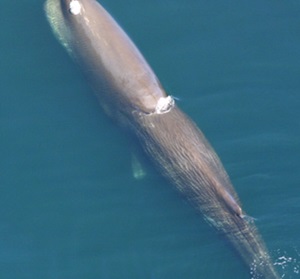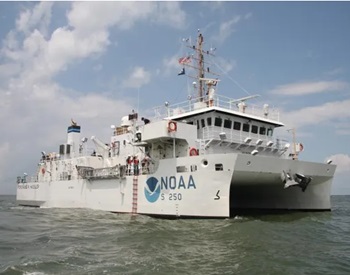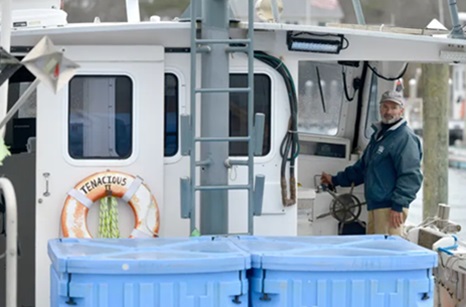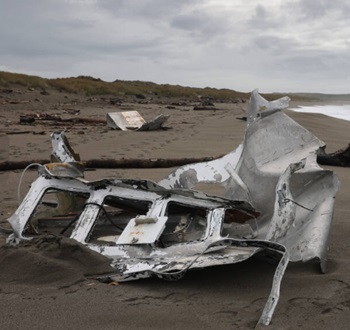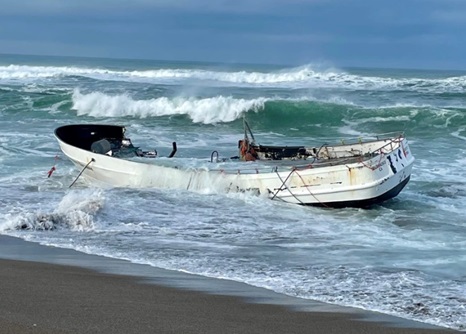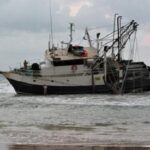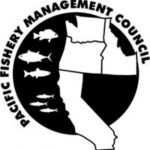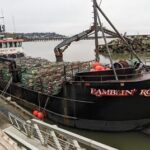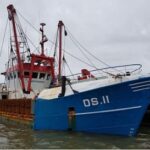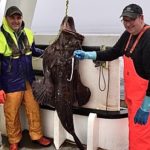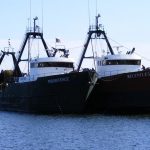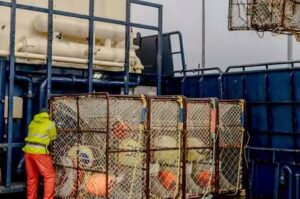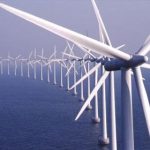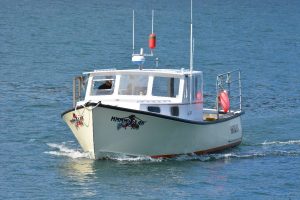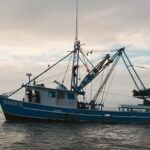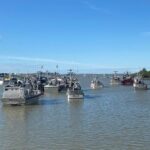Tag Archives: NOAA
Lisa Murkowski concerned with NOAA fisheries’ to list Alaska Chinook Salmon as endangered
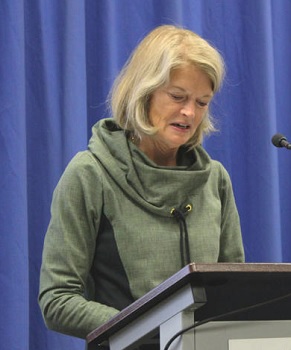 In Washington D.C. on Thursday, NOAA Fisheries announced a petition to list Gulf of Alaska Chinook Salmon as “threatened or endangered” under the Endangered Species Act. Senator Lisa Murkowski expressed her concern in the following statement: “Incredibly, NOAA is moving ahead even after finding that the Wild Fish Conservancy’s petition ‘contained numerous factual errors, omissions, incomplete references, and unsupported assertions and conclusions.’ As we fight to save our salmon and salmon fisheries alike, we need to rely on the best available science, instead of half-baked petitions intended to get conservation groups a foot in the door to attack our fisheries and resource development.” more, >>CLICK TO READ<< 09:54
In Washington D.C. on Thursday, NOAA Fisheries announced a petition to list Gulf of Alaska Chinook Salmon as “threatened or endangered” under the Endangered Species Act. Senator Lisa Murkowski expressed her concern in the following statement: “Incredibly, NOAA is moving ahead even after finding that the Wild Fish Conservancy’s petition ‘contained numerous factual errors, omissions, incomplete references, and unsupported assertions and conclusions.’ As we fight to save our salmon and salmon fisheries alike, we need to rely on the best available science, instead of half-baked petitions intended to get conservation groups a foot in the door to attack our fisheries and resource development.” more, >>CLICK TO READ<< 09:54
NOAA starts review process to list Alaska Chinooks as threatened or endangered
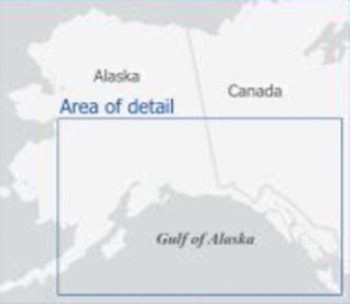 NOAA Fisheries on Thursday announced a 90-day finding on a petition to list Gulf of Alaska Chinook salmon “or any evolutionarily significant unit that may exist in the petitioned area, as a threatened or endangered species under the Endangered Species Act and to designate critical habitat concurrent with the listing.” The listing proposal comes after pressure from the Wild Fish Conservancy in Seattle, which filed a petition in January calling for federal protection of Alaska Chinook. “For decades, scientists have been sounding the alarm that Alaska’s Chinook are in dire trouble,” said Emma Helverson, executive director of the Wild Fish Conservancy. “Despite existing management plans and years of efforts by the state of Alaska, Chinook salmon continue to decline in abundance, size, diversity, and spatial structure throughout the state. Through this action, we are asking the federal government to undertake a formal status review and implement protections warranted under the Endangered Species Act, including designating critical habitat protections, to ensure the survival of these iconic fish.” more, >>CLICK TO READ<< 12:33
NOAA Fisheries on Thursday announced a 90-day finding on a petition to list Gulf of Alaska Chinook salmon “or any evolutionarily significant unit that may exist in the petitioned area, as a threatened or endangered species under the Endangered Species Act and to designate critical habitat concurrent with the listing.” The listing proposal comes after pressure from the Wild Fish Conservancy in Seattle, which filed a petition in January calling for federal protection of Alaska Chinook. “For decades, scientists have been sounding the alarm that Alaska’s Chinook are in dire trouble,” said Emma Helverson, executive director of the Wild Fish Conservancy. “Despite existing management plans and years of efforts by the state of Alaska, Chinook salmon continue to decline in abundance, size, diversity, and spatial structure throughout the state. Through this action, we are asking the federal government to undertake a formal status review and implement protections warranted under the Endangered Species Act, including designating critical habitat protections, to ensure the survival of these iconic fish.” more, >>CLICK TO READ<< 12:33
A whale washed up dead. Greens blame a Democrat.
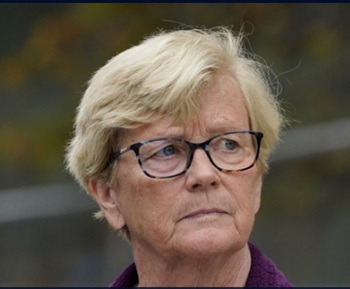 Environmentalists say Chellie Pingree’s defense of the Maine lobster industry could imperil a critically endangered whale. Doing what greens want would likely send the Democrat to political extinction. Conservation advocates are publicly pressuring Pingree to overturn a law that protects Maine’s prized lobster fishery. The calls come after one of only 360 remaining North Atlantic right whales washed up dead in February entangled in Maine lobstering rope. “I think it is a little bit more of a black mark on an otherwise fairly good conservation record,” said Brett Hartl, the government affairs director at the Center for Biological Diversity, on Pingree’s support of the pro-lobstering law. It’s a rare rebuke of a longtime ally who has a near-pristine voting record on environmental issues. Pingree says she has no plans to reverse course, but the incident highlights how lawmakers continue to balance environmental concerns with the everyday lives of their constituents. more, >>CLICK TO READ<< 17:57
Environmentalists say Chellie Pingree’s defense of the Maine lobster industry could imperil a critically endangered whale. Doing what greens want would likely send the Democrat to political extinction. Conservation advocates are publicly pressuring Pingree to overturn a law that protects Maine’s prized lobster fishery. The calls come after one of only 360 remaining North Atlantic right whales washed up dead in February entangled in Maine lobstering rope. “I think it is a little bit more of a black mark on an otherwise fairly good conservation record,” said Brett Hartl, the government affairs director at the Center for Biological Diversity, on Pingree’s support of the pro-lobstering law. It’s a rare rebuke of a longtime ally who has a near-pristine voting record on environmental issues. Pingree says she has no plans to reverse course, but the incident highlights how lawmakers continue to balance environmental concerns with the everyday lives of their constituents. more, >>CLICK TO READ<< 17:57
Technology Helping Prevent Whale Strikes
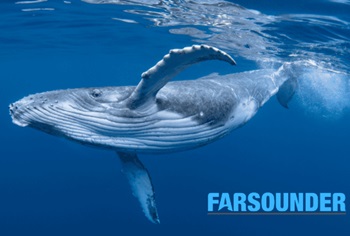 As many as 80 whales are estimated to die each year off the West Coast of the US as a result of ship strikes, and about a third of all Right Whale deaths in the Atlantic are attributed to ship strikes. Sperm Whales in the Mediterranean are also listed as an endangered species, and ship strike is their leading cause of death. Whale avoidance is clearly top of mind for mariners. It is time to explore how currently available technology can help in this endeavor. As the world looks to new technologies to assist in whale avoidance, it is important to ensure there is no impact on the whales and the environment. Likewise, as governmental regulations evolve, operating vessels near whales requires a strong understanding of the rules implemented to protect them. There should be strict adherence to safe practices that coincide with the use of the right technologies. more, >>CLICK TO READ<< 10:42
As many as 80 whales are estimated to die each year off the West Coast of the US as a result of ship strikes, and about a third of all Right Whale deaths in the Atlantic are attributed to ship strikes. Sperm Whales in the Mediterranean are also listed as an endangered species, and ship strike is their leading cause of death. Whale avoidance is clearly top of mind for mariners. It is time to explore how currently available technology can help in this endeavor. As the world looks to new technologies to assist in whale avoidance, it is important to ensure there is no impact on the whales and the environment. Likewise, as governmental regulations evolve, operating vessels near whales requires a strong understanding of the rules implemented to protect them. There should be strict adherence to safe practices that coincide with the use of the right technologies. more, >>CLICK TO READ<< 10:42
Alaska’s declining crab population due to trawlers catches attention of lawmaker
 Alaska Rep. Mary Peltola’s mounting frustration with the largely Seattle-based pollock industry’s decades-old issue of inadvertently damaging the state’s rapidly declining crab populations and critical habitat for many other species may result in legislation a move heralded by the scientific and conservation communities. Members of the scientific community concerned with sustainability and conservation are currently in a deadlock with industrial pollock trawler fleets and the North Pacific Fishery Management Council over federal fishery regulations, including pelagic, or “mid-water” trawling, which uses wide-mouthed nets designed to target schools of Bering Sea Alaskan pollock. The Alaska Marine Conservation Council released a report in February 2023 analyzing the trawlers’ impact on red king crab habitats following the 2022 closure of the Alaska snow crab fisheries, which is still ongoing, and a two-year closure for Bristol Bay king crab that ended in 2023, underscoring the devastating environmental and financial toll. more, >>CLICK TO READ<< 19:17
Alaska Rep. Mary Peltola’s mounting frustration with the largely Seattle-based pollock industry’s decades-old issue of inadvertently damaging the state’s rapidly declining crab populations and critical habitat for many other species may result in legislation a move heralded by the scientific and conservation communities. Members of the scientific community concerned with sustainability and conservation are currently in a deadlock with industrial pollock trawler fleets and the North Pacific Fishery Management Council over federal fishery regulations, including pelagic, or “mid-water” trawling, which uses wide-mouthed nets designed to target schools of Bering Sea Alaskan pollock. The Alaska Marine Conservation Council released a report in February 2023 analyzing the trawlers’ impact on red king crab habitats following the 2022 closure of the Alaska snow crab fisheries, which is still ongoing, and a two-year closure for Bristol Bay king crab that ended in 2023, underscoring the devastating environmental and financial toll. more, >>CLICK TO READ<< 19:17
Is forced labor in Indian exports affecting Louisiana shrimpers? Congress investigates
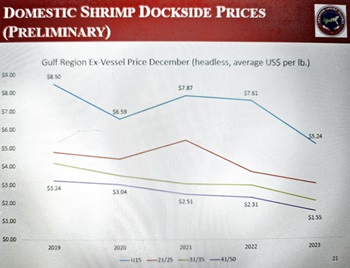 A congressional committee is investigating allegations of slave labor in the Indian shrimp industry. Such practices are among those blamed for rock-bottom shrimp prices negatively affecting Louisiana shrimpers. The House Committee on Natural Resources is investigating accusations of forced labor as well as importation of illegally obtained fish products. Additionally, the committee is looking at fraudulent reporting through the Seafood Import Monitoring Program, and the illegal use of antibiotics. The health of the American shrimp industry can often be measured by the number of landings each year. Those numbers have been on a mostly steady decline since 2001, with only five years above the downhill slope. more, >>CLICK TO READ<< 09:10
A congressional committee is investigating allegations of slave labor in the Indian shrimp industry. Such practices are among those blamed for rock-bottom shrimp prices negatively affecting Louisiana shrimpers. The House Committee on Natural Resources is investigating accusations of forced labor as well as importation of illegally obtained fish products. Additionally, the committee is looking at fraudulent reporting through the Seafood Import Monitoring Program, and the illegal use of antibiotics. The health of the American shrimp industry can often be measured by the number of landings each year. Those numbers have been on a mostly steady decline since 2001, with only five years above the downhill slope. more, >>CLICK TO READ<< 09:10
Fishermen Join Fight for Herring Trawler Rules
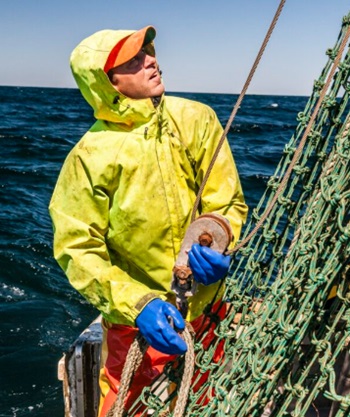 The marine ecosystem around Cape Cod is built on the backs of Atlantic herring. These baitfish school in massive numbers, providing food for marine mammals, seabirds, and large fish like cod. Their eggs, which they lay in the fall and are dense enough in spots to carpet the ocean floor, are food for crabs and other bottom-dwelling animals. They are also a $4.5-million fishery, used as bait for lobster traps, turned into canned sardines, and sold, frozen or salted, overseas. But with the Atlantic herring population in a steep decline, and the most recent attempt at a rule to protect the fish thwarted, Cape Cod fishermen are advocating for new ways to protect the species. more, >>CLICK TO READ<< 09:21
The marine ecosystem around Cape Cod is built on the backs of Atlantic herring. These baitfish school in massive numbers, providing food for marine mammals, seabirds, and large fish like cod. Their eggs, which they lay in the fall and are dense enough in spots to carpet the ocean floor, are food for crabs and other bottom-dwelling animals. They are also a $4.5-million fishery, used as bait for lobster traps, turned into canned sardines, and sold, frozen or salted, overseas. But with the Atlantic herring population in a steep decline, and the most recent attempt at a rule to protect the fish thwarted, Cape Cod fishermen are advocating for new ways to protect the species. more, >>CLICK TO READ<< 09:21
44-foot Whale Carcass on Bow of Cruise Ship Baffles NY Authorities
 Marine conservationists and government scientists are seeking clues to the mystery of how a 44-foot whale carcass ended up on the bow of a cruise liner, where it was discovered as the ship approached New York City’s Port of Brooklyn over the weekend. A necropsy, the animal equivalent of an autopsy, identified the deceased marine mammal as a mature female sei whale, an endangered species typically found in deep waters far from land, the Atlantic Marine Conservation Society said on Wednesday. One key question is whether the whale’s death came before or after its contact with the vessel, according to the non-profit organization, based in Hampton Bays, New York. Video, more, >>CLICK TO READ<< 08:54
Marine conservationists and government scientists are seeking clues to the mystery of how a 44-foot whale carcass ended up on the bow of a cruise liner, where it was discovered as the ship approached New York City’s Port of Brooklyn over the weekend. A necropsy, the animal equivalent of an autopsy, identified the deceased marine mammal as a mature female sei whale, an endangered species typically found in deep waters far from land, the Atlantic Marine Conservation Society said on Wednesday. One key question is whether the whale’s death came before or after its contact with the vessel, according to the non-profit organization, based in Hampton Bays, New York. Video, more, >>CLICK TO READ<< 08:54
Federal Waters off Texas Close to Shrimping on May 15, 2024
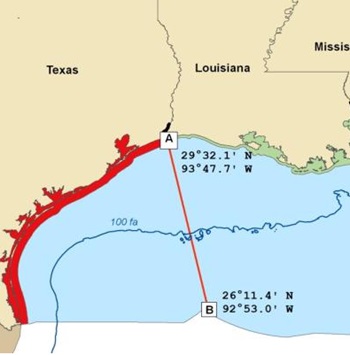 The shrimp fishery is closed annually off Texas to allow brown shrimp to reach a larger and more valuable size prior to harvest, and to prevent waste of brown shrimp that might otherwise be discarded due to their small size. The Texas closure ranges from 45 to 60 days. The closing date is based on catch rates of brown shrimp collected with seine gear by the Coastal Fisheries Division of the Texas Parks and Wildlife Department, mean length of shrimp collected in April, percent of samples containing shrimp, and periods of maximum nocturnal ebb tidal flow. Texas will re-open state waters to shrimp trawling based on sampling projections of when brown shrimp will reach a mean size of 112 mm, and when maximum duration ebb tides will occur. NOAA Fisheries will re-open federal waters off Texas when Texas re-opens its state waters. more, >>CLICK TO READ<< 11:10
The shrimp fishery is closed annually off Texas to allow brown shrimp to reach a larger and more valuable size prior to harvest, and to prevent waste of brown shrimp that might otherwise be discarded due to their small size. The Texas closure ranges from 45 to 60 days. The closing date is based on catch rates of brown shrimp collected with seine gear by the Coastal Fisheries Division of the Texas Parks and Wildlife Department, mean length of shrimp collected in April, percent of samples containing shrimp, and periods of maximum nocturnal ebb tidal flow. Texas will re-open state waters to shrimp trawling based on sampling projections of when brown shrimp will reach a mean size of 112 mm, and when maximum duration ebb tides will occur. NOAA Fisheries will re-open federal waters off Texas when Texas re-opens its state waters. more, >>CLICK TO READ<< 11:10
NOAA Breaks Ground on a New Marine Operations Center Facility in Newport, Rhode Island funded by President Biden’s Investing in America Agenda
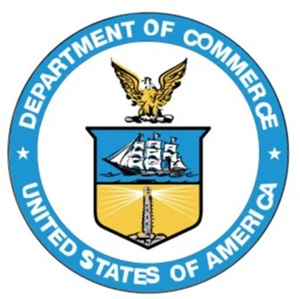 Today, the Department of Commerce’s National Oceanic and Atmospheric Administration (NOAA) held a groundbreaking ceremony for a new facility on Naval Station Newport in Rhode Island that will serve as the future home of the NOAA Marine Operations Center-Atlantic. In December, the NOAA Marine Operations Center-Atlantic, on behalf of NOAA, awarded $146,778,932 to Skanska USA to build the new NOAA facility. The design and construction of the facility is funded in part by the Inflation Reduction Act, the largest climate investment in history, as part of President Biden’s Investing in America agenda. The facility will include a pier to accommodate four large vessels, a floating dock for smaller vessels, space for vessel repairs and parking, and a building to be used for shoreside support and as a warehouse. Construction is anticipated to be completed in 2027. This project will operate under a Project Labor Agreement, consistent with EO 14063, issued by President Biden. more, >>CLICK TO READ<< 15:39
Today, the Department of Commerce’s National Oceanic and Atmospheric Administration (NOAA) held a groundbreaking ceremony for a new facility on Naval Station Newport in Rhode Island that will serve as the future home of the NOAA Marine Operations Center-Atlantic. In December, the NOAA Marine Operations Center-Atlantic, on behalf of NOAA, awarded $146,778,932 to Skanska USA to build the new NOAA facility. The design and construction of the facility is funded in part by the Inflation Reduction Act, the largest climate investment in history, as part of President Biden’s Investing in America agenda. The facility will include a pier to accommodate four large vessels, a floating dock for smaller vessels, space for vessel repairs and parking, and a building to be used for shoreside support and as a warehouse. Construction is anticipated to be completed in 2027. This project will operate under a Project Labor Agreement, consistent with EO 14063, issued by President Biden. more, >>CLICK TO READ<< 15:39
Scallop Research Set-Aside Program to Support 14 New Projects; Several 2024 Announcements Include Multi-Year Awards
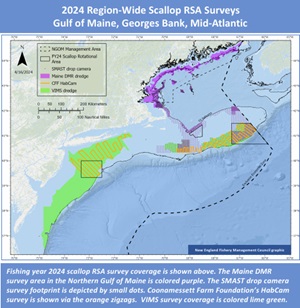 The Atlantic Sea Scallop Research Set-Aside (RSA) Program will support 14 new projects that were selected from the 2024 RSA solicitation. Several awards will support multi-year research, including a four-year regional survey effort. The set-aside harvest is expected to generate $22 million in revenue. Of that total, $5 million will fund the targeted research and $17 million will compensate industry partners who harvest the set-aside scallops. To determine the award amounts, the price of sea scallops was projected to average $14 per pound of meats. Charts, more, >>CLICK TO READ<< 12:38
The Atlantic Sea Scallop Research Set-Aside (RSA) Program will support 14 new projects that were selected from the 2024 RSA solicitation. Several awards will support multi-year research, including a four-year regional survey effort. The set-aside harvest is expected to generate $22 million in revenue. Of that total, $5 million will fund the targeted research and $17 million will compensate industry partners who harvest the set-aside scallops. To determine the award amounts, the price of sea scallops was projected to average $14 per pound of meats. Charts, more, >>CLICK TO READ<< 12:38
The federal government is assuming management of salmon fishing in parts of Alaska’s Cook Inlet
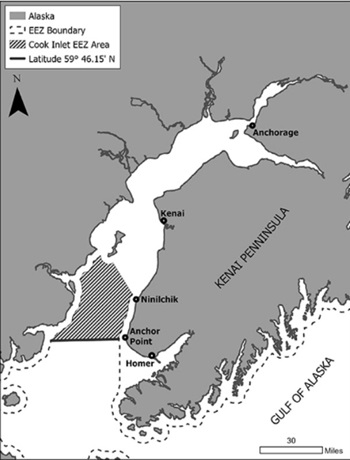 Commercial and recreational salmon fishing in the federal waters of Cook Inlet will resume this summer, but under new management by the federal government, according to a rule made final this week. Until now, the state had managed salmon fisheries in both state and federal waters of the inlet. But the switch in management was ordered by federal courts, as a result of litigation stretching back a decade. The United Cook Inlet Drift Association, or UCIDA, which is made up of commercial salmon fishers, sued the federal government in 2013 for failing to develop a salmon harvest management plan for the federal waters of the inlet. more, >>CLICK TO READ<< 13:11
Commercial and recreational salmon fishing in the federal waters of Cook Inlet will resume this summer, but under new management by the federal government, according to a rule made final this week. Until now, the state had managed salmon fisheries in both state and federal waters of the inlet. But the switch in management was ordered by federal courts, as a result of litigation stretching back a decade. The United Cook Inlet Drift Association, or UCIDA, which is made up of commercial salmon fishers, sued the federal government in 2013 for failing to develop a salmon harvest management plan for the federal waters of the inlet. more, >>CLICK TO READ<< 13:11
Dockside Safety Exam Program – Coast Guard helps commercial fishermen ensure a safe catch
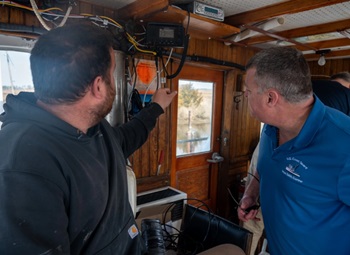 As the nation’s largest estuary, the Chesapeake Bay is a highly valued resource for more than 18 million people who live in its watershed. Producing about 500 million pounds of seafood each year, the Bay supports commercial and recreational fishing and creates one of the most economically significant regions of the Unites States. According to NOAA and the U.S. Bureau of Labor Statistics, commercial fishing is one of the country’s most dangerous occupations. “What we do for the local fishing community is support their workplace safety,” said Timothy Diehl, a Coast Guard vessel safety examiner from Sector Maryland-National Capital Region in Baltimore, Maryland. Most of Diehl’s workdays are spent traveling to area marinas where he meets with commercial fishing vessel operators and owners. Photos, more, >>CLICK TO READ<< 07:21
As the nation’s largest estuary, the Chesapeake Bay is a highly valued resource for more than 18 million people who live in its watershed. Producing about 500 million pounds of seafood each year, the Bay supports commercial and recreational fishing and creates one of the most economically significant regions of the Unites States. According to NOAA and the U.S. Bureau of Labor Statistics, commercial fishing is one of the country’s most dangerous occupations. “What we do for the local fishing community is support their workplace safety,” said Timothy Diehl, a Coast Guard vessel safety examiner from Sector Maryland-National Capital Region in Baltimore, Maryland. Most of Diehl’s workdays are spent traveling to area marinas where he meets with commercial fishing vessel operators and owners. Photos, more, >>CLICK TO READ<< 07:21
Graves, Wicker Urge NOAA to Catch Better Data for Fisheries Management
 U.S. Congressman Garret Graves and U.S. Senator Roger Wicker – along with U.S. Senate Commerce Committee Ranking Member Ted Cruz (Texas), U.S. House Natural Resources Committee Chair Bruce Westerman and 20 other bipartisan Members of Congress – urged the National Oceanic and Atmospheric Administration (NOAA) Assistant Administrator Janet Coit to modernize the data used by the National Marine Fisheries Service (NMFS) and bring better science to the table for fisheries management. “Historically, the federal government’s fisheries data management has been a failure. Their system overestimates what has been caught, which gives us less opportunity to fish. There are real solutions on the table to reverse this trend .“We know that there’s better and more precise fisheries management data being collected by the states than what the federal government can provide, and we want NMFS to use the best data and science,” said Congressman Graves. “Our children and grandchildren deserve sound science and sustainable fisheries management. more, >>CLICK TO READ<< 09:23
U.S. Congressman Garret Graves and U.S. Senator Roger Wicker – along with U.S. Senate Commerce Committee Ranking Member Ted Cruz (Texas), U.S. House Natural Resources Committee Chair Bruce Westerman and 20 other bipartisan Members of Congress – urged the National Oceanic and Atmospheric Administration (NOAA) Assistant Administrator Janet Coit to modernize the data used by the National Marine Fisheries Service (NMFS) and bring better science to the table for fisheries management. “Historically, the federal government’s fisheries data management has been a failure. Their system overestimates what has been caught, which gives us less opportunity to fish. There are real solutions on the table to reverse this trend .“We know that there’s better and more precise fisheries management data being collected by the states than what the federal government can provide, and we want NMFS to use the best data and science,” said Congressman Graves. “Our children and grandchildren deserve sound science and sustainable fisheries management. more, >>CLICK TO READ<< 09:23
Wind Energy off Morro Bay Faces Fisher Lawsuit and Marine Sanctuary Issues
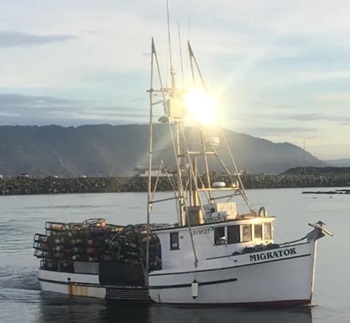 Three new wind farms in the waters north of Santa Barbara County have run into a few obstacles in their attempts to bring offshore wind to the Central Coast. On top of discussions with government agencies and the Northern Chumash tribe, the three developers face a lawsuit from two San Luis Obispo fisheries claiming that “best practices” are not being used in the process of approving and building off the coast of Morro Bay. The lawsuit was filed by the Morro Bay Commercial Fishermen’s Organization (MBCFO) and the Port San Luis Commercial Fishermen’s Association, who claim that the equipment used to survey underwater land for offshore wind development could be harmful, and possibly deadly, to sea animals in the area. They added that this would infringe on the fishermen’s right to fish and be detrimental to the commercial fishing industry in all of California. Photos, charts, more, >>CLICK TO READ<< 09:50
Three new wind farms in the waters north of Santa Barbara County have run into a few obstacles in their attempts to bring offshore wind to the Central Coast. On top of discussions with government agencies and the Northern Chumash tribe, the three developers face a lawsuit from two San Luis Obispo fisheries claiming that “best practices” are not being used in the process of approving and building off the coast of Morro Bay. The lawsuit was filed by the Morro Bay Commercial Fishermen’s Organization (MBCFO) and the Port San Luis Commercial Fishermen’s Association, who claim that the equipment used to survey underwater land for offshore wind development could be harmful, and possibly deadly, to sea animals in the area. They added that this would infringe on the fishermen’s right to fish and be detrimental to the commercial fishing industry in all of California. Photos, charts, more, >>CLICK TO READ<< 09:50
Louisiana Department of Wildlife and Fisheries given $65.2 million to aid fishing industry
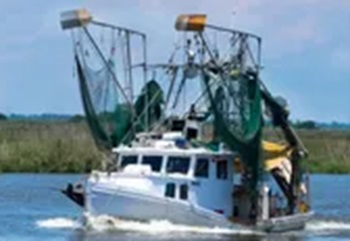 The Louisiana Department of Wildlife and Fisheries has received $65.2 million to aid the fishing industry damaged by storms and flooding. The National Oceanic and Atmospheric Administration has given the Louisiana Department of Wildlife and Fisheries two pots of money to distribute to the fishing community. It includes $38.2 million to aid the fishing industry affected by the 2019 opening of the Bonnet Carré Spillway. A separate $27 million has been given to the department to aid the fishing industry impacted by hurricanes that struck Louisiana between 2021 and 2022. The Equipment Modernization Grant offers $30,000 to applicants for reimbursement and purchase of updated and modern equipment. more, >>CLICK TO READ<< 14:53
The Louisiana Department of Wildlife and Fisheries has received $65.2 million to aid the fishing industry damaged by storms and flooding. The National Oceanic and Atmospheric Administration has given the Louisiana Department of Wildlife and Fisheries two pots of money to distribute to the fishing community. It includes $38.2 million to aid the fishing industry affected by the 2019 opening of the Bonnet Carré Spillway. A separate $27 million has been given to the department to aid the fishing industry impacted by hurricanes that struck Louisiana between 2021 and 2022. The Equipment Modernization Grant offers $30,000 to applicants for reimbursement and purchase of updated and modern equipment. more, >>CLICK TO READ<< 14:53
Federal Funding Allocated for Salmon Fishing Disaster
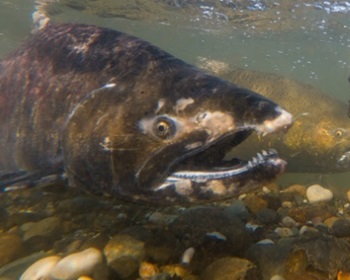 On April 6, 2023, the Pacific Fishery Management Council (PFMC) acted unanimously to recommend a full closure of California’s 2023 commercial and recreational ocean salmon seasons due to extremely low population estimates for Sacramento and Klamath river fall Chinook salmon. Within hours of the recommendation, Gov. Gavin Newsom announced his administration’s request for a federal fishery disaster declaration to support impacted communities. Looking ahead to the 2024 season, the PFMC will consider the alternatives for the 2024 salmon seasons at its meeting April 5-11 in Seattle. This meeting is open to the public. more, >>click to read<< 11:45
On April 6, 2023, the Pacific Fishery Management Council (PFMC) acted unanimously to recommend a full closure of California’s 2023 commercial and recreational ocean salmon seasons due to extremely low population estimates for Sacramento and Klamath river fall Chinook salmon. Within hours of the recommendation, Gov. Gavin Newsom announced his administration’s request for a federal fishery disaster declaration to support impacted communities. Looking ahead to the 2024 season, the PFMC will consider the alternatives for the 2024 salmon seasons at its meeting April 5-11 in Seattle. This meeting is open to the public. more, >>click to read<< 11:45
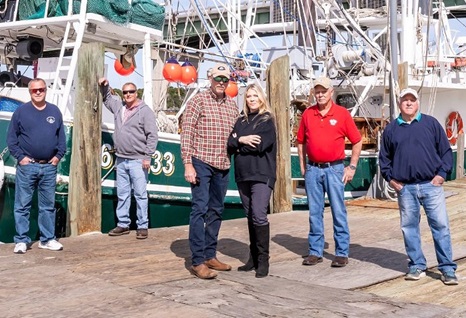
Coastal Georgia Shrimping: A new season of uncertainty, possibilities and hope
In a word, “difficult,” said Dee Kicklighter of their most recent shrimping season. Kicklighter, who has worked with Mathews for about eight years, has seen first-hand how the unpredictability of the business can be costly. “You plan for something to be one price, and then the next week you come back, and it could be potentially thousands of dollars more, depending on what you’re dealing with,” he said of fluctuating prices, including fuel. Over the years, Mathews said the ever-changing cost of fuel has taken a toll on the number of shrimpers in the industry. It’s not just Georgia shrimpers contending with the negative effects from imports. North Carolina, Texas, Louisiana, Florida and other coastal states are also feeling the friction of narrowing profit margins that threaten their way of life. Photos, more, >>click to read<< 09:15
Offshore wind or tribal rights? Biden’s California dilemma.
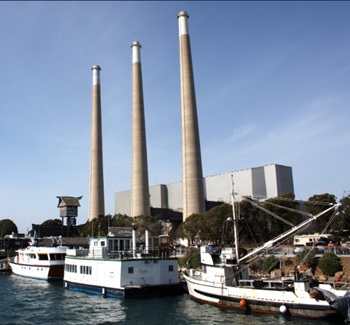 Several offshore wind developers want to build the state’s first farms off the coast here, projects that are needed for California and the White House to reach decarbonization goals. But this summer, the administration is also likely to designate the Chumash Heritage National Marine Sanctuary in coastal waters that surround Morro Bay, a plan that the offshore wind industry says blocks their access to the grid. Equinor, Golden State Wind and Invenergy California Offshore, companies with offshore wind farms planned off the bay, hope to carve out guaranteed paths for their power lines to reach shore, when the NOAA finalizes the sanctuary in coming months. “The ocean should not be the sacrificial lamb for our unquenchable thirst for energy,” said Violet Sage Walker, chair of the Northern Chumash Tribal Council, the Indigenous tibe that proposed the marinre sanctuary to NOAA. more, >>click to read<< 09:29
Several offshore wind developers want to build the state’s first farms off the coast here, projects that are needed for California and the White House to reach decarbonization goals. But this summer, the administration is also likely to designate the Chumash Heritage National Marine Sanctuary in coastal waters that surround Morro Bay, a plan that the offshore wind industry says blocks their access to the grid. Equinor, Golden State Wind and Invenergy California Offshore, companies with offshore wind farms planned off the bay, hope to carve out guaranteed paths for their power lines to reach shore, when the NOAA finalizes the sanctuary in coming months. “The ocean should not be the sacrificial lamb for our unquenchable thirst for energy,” said Violet Sage Walker, chair of the Northern Chumash Tribal Council, the Indigenous tibe that proposed the marinre sanctuary to NOAA. more, >>click to read<< 09:29
Regional council says it won’t tighten fishing regulations in Bristol Bay red king crab savings area
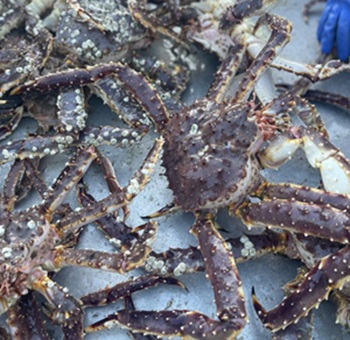 The North Pacific Fishery Management Council will not move forward with a request to close the Bristol Bay red king crab savings area to all commercial fishing. At its February meeting, the regulatory council looked at the effectiveness of closing the 4,000-square-nautical-mile section of the eastern Bering Sea to commercial trawl, pot and longline fishing, but decided not to tighten regulations in the area. The savings box was established in 1996 as a haven for the massive crab species. It is already permanently closed to bottom trawling, but it remains open to midwater, or pelagic trawlers, pot fishing and longlining. Non-pelagic, known as bottom trawling, is allowed in a small section within the savings area — known as the savings subarea — when crabbers are harvesting the species. The council also evaluated a pot gear closure of a large section in the eastern portion of Bristol Bay, known as Area 512, to address drops in the Bristol Bay red king crab stock. All trawling is already prohibited in that area. more, >>click to read<< 12:38
The North Pacific Fishery Management Council will not move forward with a request to close the Bristol Bay red king crab savings area to all commercial fishing. At its February meeting, the regulatory council looked at the effectiveness of closing the 4,000-square-nautical-mile section of the eastern Bering Sea to commercial trawl, pot and longline fishing, but decided not to tighten regulations in the area. The savings box was established in 1996 as a haven for the massive crab species. It is already permanently closed to bottom trawling, but it remains open to midwater, or pelagic trawlers, pot fishing and longlining. Non-pelagic, known as bottom trawling, is allowed in a small section within the savings area — known as the savings subarea — when crabbers are harvesting the species. The council also evaluated a pot gear closure of a large section in the eastern portion of Bristol Bay, known as Area 512, to address drops in the Bristol Bay red king crab stock. All trawling is already prohibited in that area. more, >>click to read<< 12:38
NOAA postpones controversial bottom trawling experiment in Alaska’s Northern Bering Sea
 The project, called the Northern Bering Sea Effects of Trawling Study, or NETS, has been envisioned as an experiment to examine impacts of commercial bottom trawling in an area of the Bering Sea where it is currently banned. Bottom trawling is a method of fish harvesting that uses nets to sweep the seafloor. While it is prohibited in the Northern Bering Sea, the shift in fish populations caused by climate change may build pressure for bottom trawling there in the future, according to the study plan. The study has been designed as a multiyear project to start as early as this August. It was to be conducted by the Alaska Fisheries Science Center, a branch of the National Oceanic and Atmospheric Administration’s Fisheries Service, also known as the National Marine Fisheries Service. News of the decision came in an emailed letter from Janet Coit, director of NOAA Fisheries, to tribal organizations that had expressed opposition to the project. more, >>click to read<< 09:52
The project, called the Northern Bering Sea Effects of Trawling Study, or NETS, has been envisioned as an experiment to examine impacts of commercial bottom trawling in an area of the Bering Sea where it is currently banned. Bottom trawling is a method of fish harvesting that uses nets to sweep the seafloor. While it is prohibited in the Northern Bering Sea, the shift in fish populations caused by climate change may build pressure for bottom trawling there in the future, according to the study plan. The study has been designed as a multiyear project to start as early as this August. It was to be conducted by the Alaska Fisheries Science Center, a branch of the National Oceanic and Atmospheric Administration’s Fisheries Service, also known as the National Marine Fisheries Service. News of the decision came in an emailed letter from Janet Coit, director of NOAA Fisheries, to tribal organizations that had expressed opposition to the project. more, >>click to read<< 09:52
Offshore Wind Lease Areas Impede on Historic Fishing Grounds
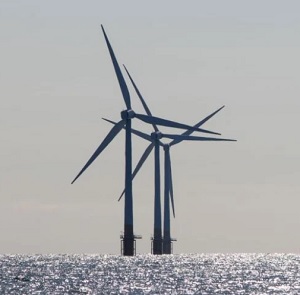 In announcing its decision Monday (the initial deadline for comment), BOEM said it received requests from tribal nations and stakeholders to provide more time to review and comment on the lengthy environmental document. The decision also came on the 40th anniversary of COA’s incorporation. “When we started in 1984, the ocean was the dumping capital of the world. We worked really hard to clean it up and in 2000 we ended ocean dumping. (That’s) the power of the people,” Cindy Zipf, COA executive director, said. Since then, the Atlantic Ocean has thrived, she added. “We’ve seen majestic animals and (the) bounty of what she (the ocean) provides (us) free,” Zipf said. “What’s the return now? There’s a bunch of people that want to industrialize the ocean to claim some green energy revolution, but the facts aren’t there. We don’t see them.” more, by Gina G. Scala, >>click to read<< 10:41
In announcing its decision Monday (the initial deadline for comment), BOEM said it received requests from tribal nations and stakeholders to provide more time to review and comment on the lengthy environmental document. The decision also came on the 40th anniversary of COA’s incorporation. “When we started in 1984, the ocean was the dumping capital of the world. We worked really hard to clean it up and in 2000 we ended ocean dumping. (That’s) the power of the people,” Cindy Zipf, COA executive director, said. Since then, the Atlantic Ocean has thrived, she added. “We’ve seen majestic animals and (the) bounty of what she (the ocean) provides (us) free,” Zipf said. “What’s the return now? There’s a bunch of people that want to industrialize the ocean to claim some green energy revolution, but the facts aren’t there. We don’t see them.” more, by Gina G. Scala, >>click to read<< 10:41
Endangered coho salmon: California’s comeback kid with ‘surprisingly strong’ spawning season, says NPS
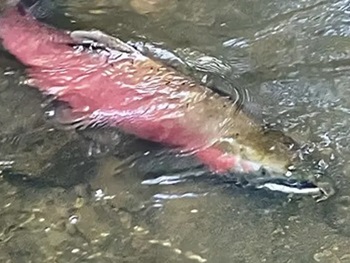 California’s coho salmon have made a surprising comeback. The 2023-24 spawning season is on track to be the best in more than 15 years, said the National Park Service in a statement. “On one of the creeks, Olema Creek, the one that we saw the most spawning on, we thought we’d see somewhere in the neighborhood of around 40 nests,” National Park Service Fishery Biologist Michael Reichmuth said. “And we’re looking at double that. So, that’s a pretty big surprise and encouraging to see those kinds of numbers because it means the fish had high survival through their life, getting to that point.” “We had an epic day on Olema, with a single-day count of 150 adult coho salmon. This is the highest single-day count that we have (ever) recorded,” he said. Video, photos, more, >>click to read<< 14:31
California’s coho salmon have made a surprising comeback. The 2023-24 spawning season is on track to be the best in more than 15 years, said the National Park Service in a statement. “On one of the creeks, Olema Creek, the one that we saw the most spawning on, we thought we’d see somewhere in the neighborhood of around 40 nests,” National Park Service Fishery Biologist Michael Reichmuth said. “And we’re looking at double that. So, that’s a pretty big surprise and encouraging to see those kinds of numbers because it means the fish had high survival through their life, getting to that point.” “We had an epic day on Olema, with a single-day count of 150 adult coho salmon. This is the highest single-day count that we have (ever) recorded,” he said. Video, photos, more, >>click to read<< 14:31
Grants available for municipal and regional projects in coastal communities
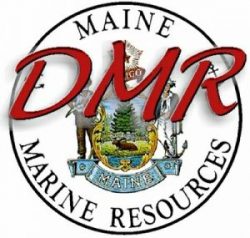 The Department of Marine Resources’ Maine Coastal Program (MCP) and the Department of Agriculture, Conservation and Forestry’s Municipal Planning Assistance Program (MPAP) are seeking applications for coastal planning grants totaling approximately $300,000. Funding for these planning grants comes from the Maine Coastal Program’s annual grant from the National Oceanic and Atmospheric Administration (NOAA). In response to the significant impacts of recent storms experienced by Maine’s coastal communities, the FY 2025 Coastal Community Grant Program and Shore and Harbor Planning Grant Program are being combined into one grant program. The matching fund requirement has been eliminated and the application process has been modified to include a Letter of Intent, followed by a final application by invitation only. Lots of links, and information. more >>click to read<< 16:39
The Department of Marine Resources’ Maine Coastal Program (MCP) and the Department of Agriculture, Conservation and Forestry’s Municipal Planning Assistance Program (MPAP) are seeking applications for coastal planning grants totaling approximately $300,000. Funding for these planning grants comes from the Maine Coastal Program’s annual grant from the National Oceanic and Atmospheric Administration (NOAA). In response to the significant impacts of recent storms experienced by Maine’s coastal communities, the FY 2025 Coastal Community Grant Program and Shore and Harbor Planning Grant Program are being combined into one grant program. The matching fund requirement has been eliminated and the application process has been modified to include a Letter of Intent, followed by a final application by invitation only. Lots of links, and information. more >>click to read<< 16:39
Maine lobster industry reacts to right whale found entangled in rope
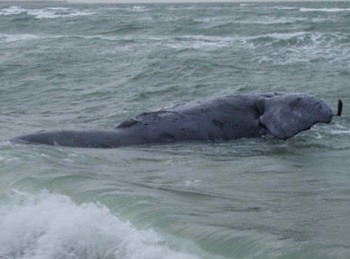 Maine’s lobster industry is responding following the discovery of a dead North Atlantic right whale near Martha’s Vineyard last month. According to federal authorities, the whale was entangled in fishing rope, including portions traced back to Maine. While NOAA has yet to determine the exact cause of the whale’s demise, Maine lobstermen are fearing potential blame. “They’re going to say that the rope, you know, caused harm to the whale, and over time, it just was a very slow death,” said John Drouin, a Lobsterman from Cutler with over 40 years of experience. The incident marks the first documented interaction between a right whale and Maine fishing gear in over two decades. more, >>click to read<< 11:49
Maine’s lobster industry is responding following the discovery of a dead North Atlantic right whale near Martha’s Vineyard last month. According to federal authorities, the whale was entangled in fishing rope, including portions traced back to Maine. While NOAA has yet to determine the exact cause of the whale’s demise, Maine lobstermen are fearing potential blame. “They’re going to say that the rope, you know, caused harm to the whale, and over time, it just was a very slow death,” said John Drouin, a Lobsterman from Cutler with over 40 years of experience. The incident marks the first documented interaction between a right whale and Maine fishing gear in over two decades. more, >>click to read<< 11:49






